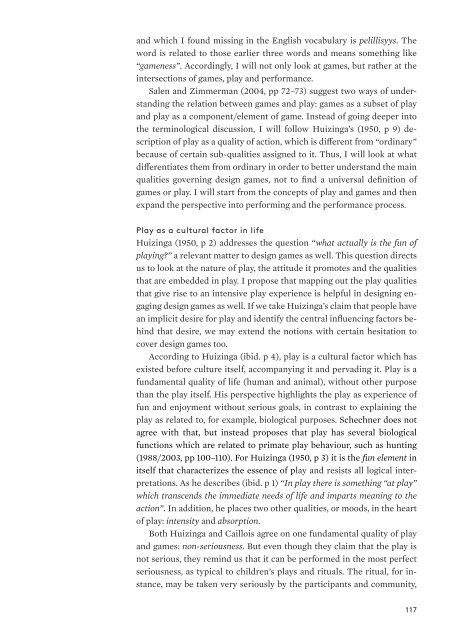Design games as a tool, a mindset and a structure Kirsikka Vaajakallio
Design games as a tool, a mindset and a structure Kirsikka Vaajakallio
Design games as a tool, a mindset and a structure Kirsikka Vaajakallio
You also want an ePaper? Increase the reach of your titles
YUMPU automatically turns print PDFs into web optimized ePapers that Google loves.
<strong>and</strong> which I found missing in the English vocabulary is pelillisyys. The<br />
word is related to those earlier three words <strong>and</strong> means something like<br />
“gameness”. Accordingly, I will not only look at <strong>games</strong>, but rather at the<br />
intersections of <strong>games</strong>, play <strong>and</strong> performance.<br />
Salen <strong>and</strong> Zimmerman (2004, pp 72–73) suggest two ways of underst<strong>and</strong>ing<br />
the relation between <strong>games</strong> <strong>and</strong> play: <strong>games</strong> <strong>as</strong> a subset of play<br />
<strong>and</strong> play <strong>as</strong> a component/element of game. Instead of going deeper into<br />
the terminological discussion, I will follow Huizinga’s (1950, p 9) description<br />
of play <strong>as</strong> a quality of action, which is different from “ordinary”<br />
because of certain sub-qualities <strong>as</strong>signed to it. Thus, I will look at what<br />
differentiates them from ordinary in order to better underst<strong>and</strong> the main<br />
qualities governing design <strong>games</strong>, not to find a universal definition of<br />
<strong>games</strong> or play. I will start from the concepts of play <strong>and</strong> <strong>games</strong> <strong>and</strong> then<br />
exp<strong>and</strong> the perspective into performing <strong>and</strong> the performance process.<br />
Play <strong>as</strong> a cultural factor in life<br />
Huizinga (1950, p 2) addresses the question “what actually is the fun of<br />
playing?” a relevant matter to design <strong>games</strong> <strong>as</strong> well. This question directs<br />
us to look at the nature of play, the attitude it promotes <strong>and</strong> the qualities<br />
that are embedded in play. I propose that mapping out the play qualities<br />
that give rise to an intensive play experience is helpful in designing engaging<br />
design <strong>games</strong> <strong>as</strong> well. If we take Huizinga’s claim that people have<br />
an implicit desire for play <strong>and</strong> identify the central influencing factors behind<br />
that desire, we may extend the notions with certain hesitation to<br />
cover design <strong>games</strong> too.<br />
According to Huizinga (ibid. p 4), play is a cultural factor which h<strong>as</strong><br />
existed before culture itself, accompanying it <strong>and</strong> pervading it. Play is a<br />
fundamental quality of life (human <strong>and</strong> animal), without other purpose<br />
than the play itself. His perspective highlights the play <strong>as</strong> experience of<br />
fun <strong>and</strong> enjoyment without serious goals, in contr<strong>as</strong>t to explaining the<br />
play <strong>as</strong> related to, for example, biological purposes. Schechner does not<br />
agree with that, but instead proposes that play h<strong>as</strong> several biological<br />
functions which are related to primate play behaviour, such <strong>as</strong> hunting<br />
(1988/2003, pp 100–110). For Huizinga (1950, p 3) it is the fun element in<br />
itself that characterizes the essence of play <strong>and</strong> resists all logical interpretations.<br />
As he describes (ibid. p 1) “In play there is something “at play”<br />
which transcends the immediate needs of life <strong>and</strong> imparts meaning to the<br />
action”. In addition, he places two other qualities, or moods, in the heart<br />
of play: intensity <strong>and</strong> absorption.<br />
Both Huizinga <strong>and</strong> Caillois agree on one fundamental quality of play<br />
<strong>and</strong> <strong>games</strong>: non-seriousness. But even though they claim that the play is<br />
not serious, they remind us that it can be performed in the most perfect<br />
seriousness, <strong>as</strong> typical to children’s plays <strong>and</strong> rituals. The ritual, for instance,<br />
may be taken very seriously by the participants <strong>and</strong> community,<br />
117
















